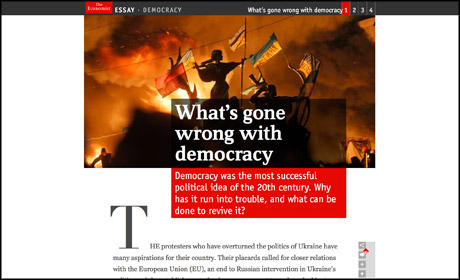
The Economist has launched a new digital-first series called Essays, adopting an immersive storytelling style to deliver content outside the "constraints of print".
The series, which started with Democracy, was "an opportunity to start doing things in a different way", digital editor Tom Standage told Journalism.co.uk, to "build for digital-first".
The introduction of the series, which will publish eight Essays a year, signals an interest in the "trend towards single column or much simpler design", Standage explained, which in turn supports a more "immersive reading" experience, as the Economist has already seen from its app engagement statistics.
"We wanted to bring that to our website," he explained, adding that the "idea is it's not designed with constraints of print".
Interactivity 'baked-in from the beginning'
One of the key features of the Essays feature style is that the multimedia and interactive elements are part of the strategy and planning from the start. In the Democracy piece, for example, the feature includes two interactive elements: a heat map and a timeline.
Previously, Standage said, such content may not have been considered "early enough in the process". Instead, when Essays are built, such content will be "baked-in from the beginning", supported by a team – consisting of the writer, and multimedia, design, interactive and user experience team members – working collaboratively throughout the production.
The team behind an Essay will meet on a weekly basis, Standage added, and the entire process is "more like building an app than editing an article".
As part of building the first Essay example, the team has created "a responsive container", which Standage said "can be used for all sorts of things". In fact, this is the Economist's "first fully responsive page", he said.
But the team will "build new interactive components each time we do this" to enable a high degree of flexibility and diversity from one project to another. In the future, particularly successful interactives can be made into templates for ease of re-use, but for now the idea is to use the 'responsive container' as a "Petri dish for trying out new things", he said.
This experimentation also applies on the commercial side. The Democracy Essay, for example, is sponsored, with the sponsors given a logo within a widget which remains near the top right-hand-side of the feature throughout scrolling.
The sponsor also receives an advert mid-way through the Essay, which Standage said is the "same format as a full-screen iPad ad", which, he added, is both well-regarded by advertisers and also "familiar to readers".
"It's an experiment for a new approach there, we take the same creative we run in the iPad edition and run it on the web".
He added that the Economist will be keen to look at the data to see exactly how people are interacting with the feature.
While Democracy is openly accessible for now, future Essays will have the Economist's metered paywall applied to them. The model gives non-subscribers just one click on an article each week, or three articles once registered.
Free daily newsletter
If you like our news and feature articles, you can sign up to receive our free daily (Mon-Fri) email newsletter (mobile friendly).
Related articles
- Four digital media trends to watch: generative AI, Gen Z, business models and news formats
- Deep listening and feedback loops: Using the news to tackle polarisation
- Mobile journalists Sabbir Ahmed and Jamil Khan on creating a mobile-first newsroom
- "You’re not writing the hardest-hitting stories but they mean something to someone"
- Tip: Five design tips to make your story stand out









